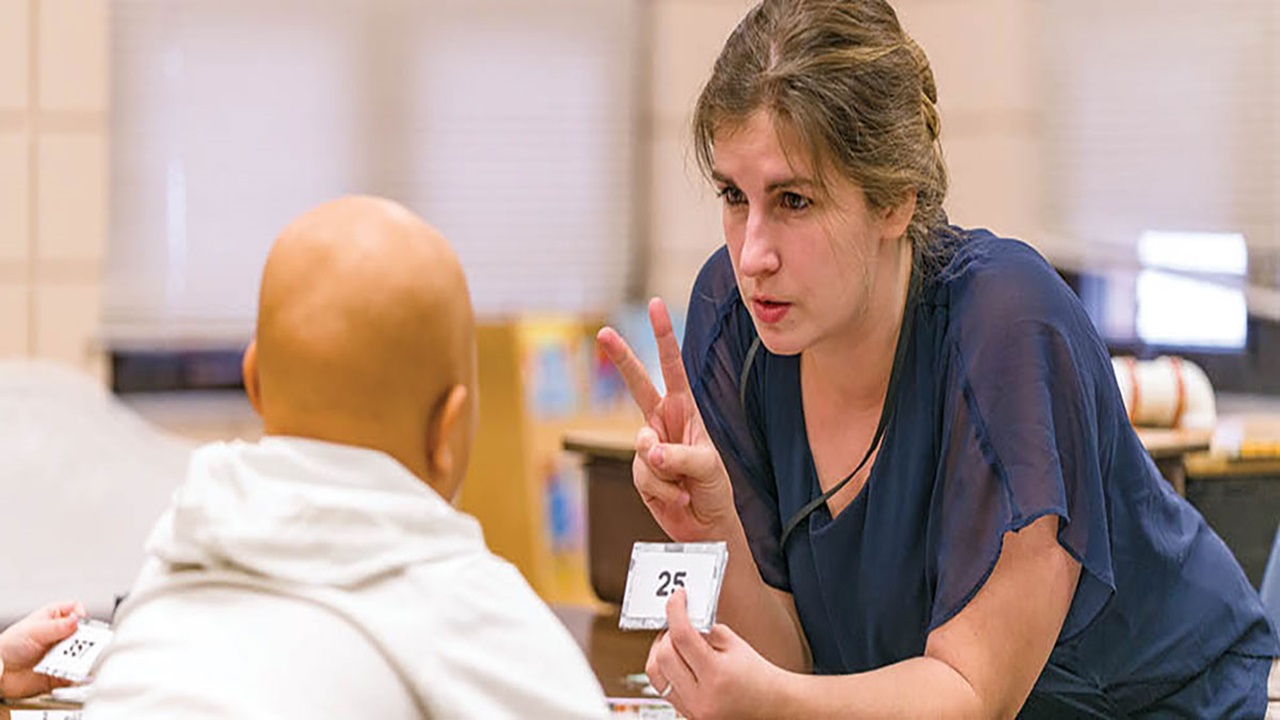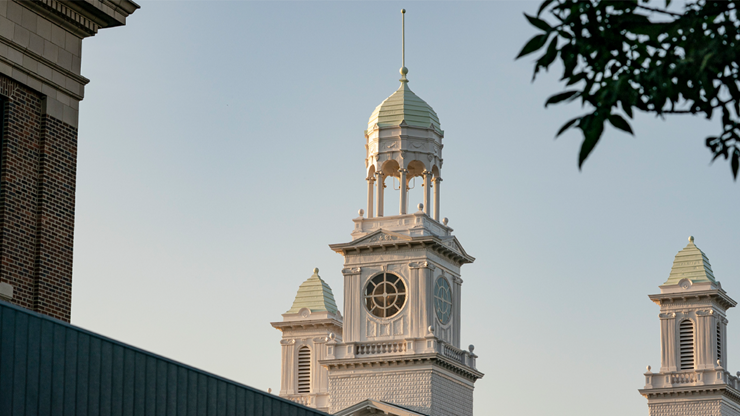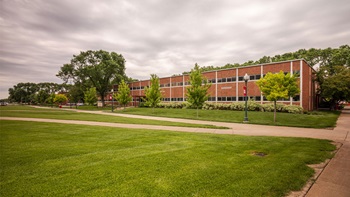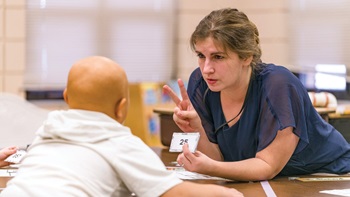Creating Opportunities and Catalyzing Change

Education is opportunity: a chance to learn something new and use that knowledge to make a difference. And since anyone can make a difference, then everyone—regardless of who they are or where they’re from—deserves that opportunity.
After all, it’s the diversity of others’ perspectives that teaches us to think in new ways. Without working together and empowering students to learn with an open mind, we miss some of our best opportunities for growth.
The University of South Dakota School of Education embodies opportunity not only by honoring the unique perspective every student brings to the classroom; they provide innovative ways to get students involved with education. In doing so, they set the example that a teacher is one who encourages all voices to be heard, because there is no shortage of lessons we can learn when exposed to new perspectives.
There is, however, a shortage of teachers.
Schools everywhere are struggling to fill teaching vacancies, especially at current wages, with those who are qualified to teach in fields of need. Nationwide research by the Economic Policy Institute indicated that about 110,000 positions remained open in 2018; that number could reach 200,000 by 2025.
Locally, an Associated School Boards of South Dakota survey conducted in spring 2014 revealed that nearly all of South Dakota’s school districts struggled to fill teaching positions for the upcoming school year. By the end of that May, more than 30 percent of openings had yet to be filled. No district or discipline was exempt from what superintendents, administrators and teachers deemed “a crisis in the classroom.”
Critical situations prompt immediate action, and the need to serve our students was no exception. The South Dakota Board of Education has since initiated efforts to improve teacher salaries and certification processes to help with recruitment and retention. As these efforts unfold, so do their potential, and the School of Education has seen the need.
The response? Make every effort to serve that need and make a positive impact.
In the Community
Fall of 2019 offered new opportunities for aspiring educators, especially in rural communities. The School of Education introduced its online Graduate Certificate for Alternative Teacher Certification to help those working in other professions become certified teachers.
“This is an ideal program for someone who has a bachelor’s degree and wants to pursue alternative certification through the South Dakota Department of Education,” said Sherrie Bosse, Ed.D., senior lecturer and director of academic advising and student engagement in USD’s School of Education. “The program’s adaptability and one-year time frame equip students to prepare for certification, all while being employed by a school district.”
The graduate certificate supplements alternative certification by fulfilling the state’s requirement for 15 credit hours of coursework. Program participants can be hired by a school district with the understanding that they are working toward certification—part of which includes taking classes on classroom management, South Dakota Indian Studies and more.
The School of Education offers all these courses online, eliminating the need for certificate seekers to leave their communities. With coursework completed, tests passed and signoff received from their school district, participants are awarded their general education alternative certification. These credentials allow them to teach grades 5 through 12 in the state of South Dakota.
“The format is especially beneficial for rural communities where there’s really a need for teachers,” Bosse said. “It gives districts an opportunity to enable people who have roots in the area and opens doors for students to witness the excellent teaching potential that’s already there.”
According to a USDA Economic Research Service report, in 2018, a reported 452,214 of South Dakota’s 882,235 residents were living in rural areas; that’s just over 50 percent. Given these geographical roadblocks, the School of Education is taking the initiative to close gaps between teachers and classrooms, both virtually and literally. And they’re not alone. Partnerships with not only the state but also the schools themselves are providing people of all backgrounds with hands-on experience.
In the Classroom
One of education’s most powerful gifts is its longevity: it’s a dynamic, lifelong process that holds infinite potential. As we all know, whether in school or life, the best way to learn is by experience. Only by applying yourself and your perspective to a concept, problem or situation will you interpret personal meaning. If things don’t turn out the way you expect, then you’ll still have learned a valuable lesson, which—like it or not—is an opportunity for growth.
Understanding that minds can change in any stage of life, the School of Education and Sioux Falls School District chose to be part of the solution. The two formed a partnership in 2017 to give prospective teachers (especially those switching from other professions) on-site experience for college credit.
It started when James Nold, assistant superintendent in the Sioux Falls School District, noticed that those who took alternative routes to education careers were missing out on in-field experience. As a former high school principal, he saw incredibly capable teachers who could benefit from student teaching experience in the form of internships.
“We started looking for ways to provide classroom experience with highly qualified teachers while getting credit they could apply to their certificate or master’s degree,” said Nold, who received his Ed.D. from the USD School of Education in 2018. “The internship program came about to bridge that gap.”
The resulting program offers nine weeks of paid, hands-on experience to educational assistants, business employees and anyone else in the community considering becoming teachers. Additionally, interns receive credit toward their teaching certification or master’s degrees through USD’s School of Education.
“Between their strengths and this programming, interns receive a holistic experience in the education system that helps them determine whether they want to be part of it,” Nold said.
The Student’s Voice: Emily Kern
In fall 2017, Emily Kern was one of the program’s first interns. She applied and was accepted for an internship, hoping it would help her decide whether she wanted to further her education degree or pursue a path in social work.
For nine weeks she worked with a special education and resource teacher at an elementary school in Sioux Falls. There she learned about everything from individualized education programs to the role she could play within a school.
“I was able to interact with students and really be part of the system,” Kern said, “which showed me the parts you don’t always see if you’re not in education.”
By the end of her internship, Kern knew she wanted to fill the role of an educator. She applied for the special education master’s program at USD, where she could transfer the credit for her internship experience. She then worked as a roving educational assistant within the Sioux Falls School District while a full-time student.
Upon graduation and certification, she was employed as a special education teacher at John F. Kennedy Elementary School in Sioux Falls. She cited the whole experience as one that empowered her to try a different career route, learn something new and decide whether it worked for her.
“Once you’re done with college, it’s hard to explore other career opportunities,” Kern said, “so the internship changed everything for me. I got to be involved with educators who taught me that life keeps going, and you can always do something different."
For the Next Generation
Ask anyone in education: it’s never too late—or too early—to impact the future. High school is a time for career exploration, and tomorrow’s professionals are being exposed to their opportunities at progressively younger ages. By helping students conceptualize what they want for their futures, we can help them prepare to make a difference in their communities. However, we can’t reach success without removing barriers, and we certainly can’t do it alone.
The Teacher Pathway program is another partnership between the Sioux Falls School District and the School of Education that’s helping create equitable opportunities for students. This joint program lets juniors and seniors take courses in public Sioux Falls high schools that prepare them for careers in education. Students then learn culturally responsive teaching practices and perspectives while earning college credit at a reduced price.
“The whole goal of Teacher Pathway is to not only raise awareness of the teaching profession, but to increase diversity in the profession as well,” said April Lee, a recruiter in the School of Education. The teacher shortage applies to educators of all backgrounds, which in turn impacts students and their classroom environments. While more than one-third of students in the Sioux Falls School District are students of color, 98 percent of their teachers are white.
Nold, too, is passionate about diversity. He stated that both Teacher Pathway and the internship program exist as opportunities for individuals to see the benefits and rewards of a career in education, while encouraging individuals with diverse backgrounds to try education careers.
“Ultimately, we want to remove barriers and provide access and opportunities that help anyone who needs it to pursue higher education,” said Lee, “and our partnership with Sioux Falls has been really rewarding for everyone involved.”
Their awareness efforts include the Teacher Pathway visit day, which allows students who are taking the courses to tour USD, where they can get a feel for the campus, experience college classes and learn more about the teaching profession.
According to Lee, the School of Education is working on a similar program with school districts in Omaha, Nebraska. More partnerships provide new opportunities to widen the net for applicants, promote culturally responsive teaching practices and give students more options for their yearlong student teaching residencies.
Preparing Tomorrow's Professionals
The 2018–2019 school year marked Teacher Pathway’s first full cohort, totaling 116 students. The program functions much like a dual credit course, but due to its external funding, is still available to students who don’t qualify for dual credit.
After being trained on the curriculum material, high school teachers embed lessons from two separate courses—Foundations of American Education and Field Experience— into classes they’re already teaching. Students in the Teacher Pathway program can opt to earn college credit that transfers directly to the student’s chosen university, should the student decide to continue toward teacher certification.
A large group of high school students attending USD's Teacher Pathway program
Even students who don’t want to be teachers benefit from the material. Taken for credit or not, the Teacher Pathway courses implement lessons on the inner workings of education and cultural responsiveness. Before graduating, students gain new perspectives of their school systems and know they have a voice within one.
“Giving these young adults the opportunity to better understand education, and what a teacher does, will help them be better parts of their own school district in the future—even if they’re not employed by one,” said Nold.
Students then take this opportunity one step further through field experience. One day per week, they work in elementary schools alongside teachers, observing interactions and learning the pedagogical ropes. Whether they’re helping grade papers or walking through lesson plans, these students are seeing what their futures could look like.
The Student’s Voice: Addison Miller
Addison Miller is one of those students. He knows he wants to change the lives of people and, during his junior year of high school, was thinking about doing so as a politician. After hearing about Teacher Pathway, he enrolled in the program that changed his mind and his future.
Miller finished the program having decided that teaching was how he wanted to make a difference. He graduated from high school and took his Teacher Pathway credits straight to the School of Education, where he’s now a first-year student—and loving it.
“It’s awesome to be at a school that really puts forth the effort into making the education school as good as it can be,” he said. Miller is majoring in political science and working toward his teacher certification, while minoring in history and English. His goal is to teach high school government and political science.
He’s not alone: four of his high school classmates followed the Teacher Pathway and are now in their first year at USD’s School of Education. This handful of students is just a few of the many who have embraced an opportunity that changed their futures. Now, they’re learning to help others do the same.
For the Future
Education is opportunity, and areas of need hold infinite potential for growth and positive impact. Whether by supplementing existing programs or creating new, the School of Education continues to be a catalyst for change in the availability of education for students of all backgrounds.
After all, paralleling opportunity is educators’ responsibility to help our students succeed. That’s why we work together: we build students up and break their barriers down. Because if life’s greatest opportunities are never made available, then the world’s most impactful voices might never be heard—and that is a chance we cannot afford to take.



